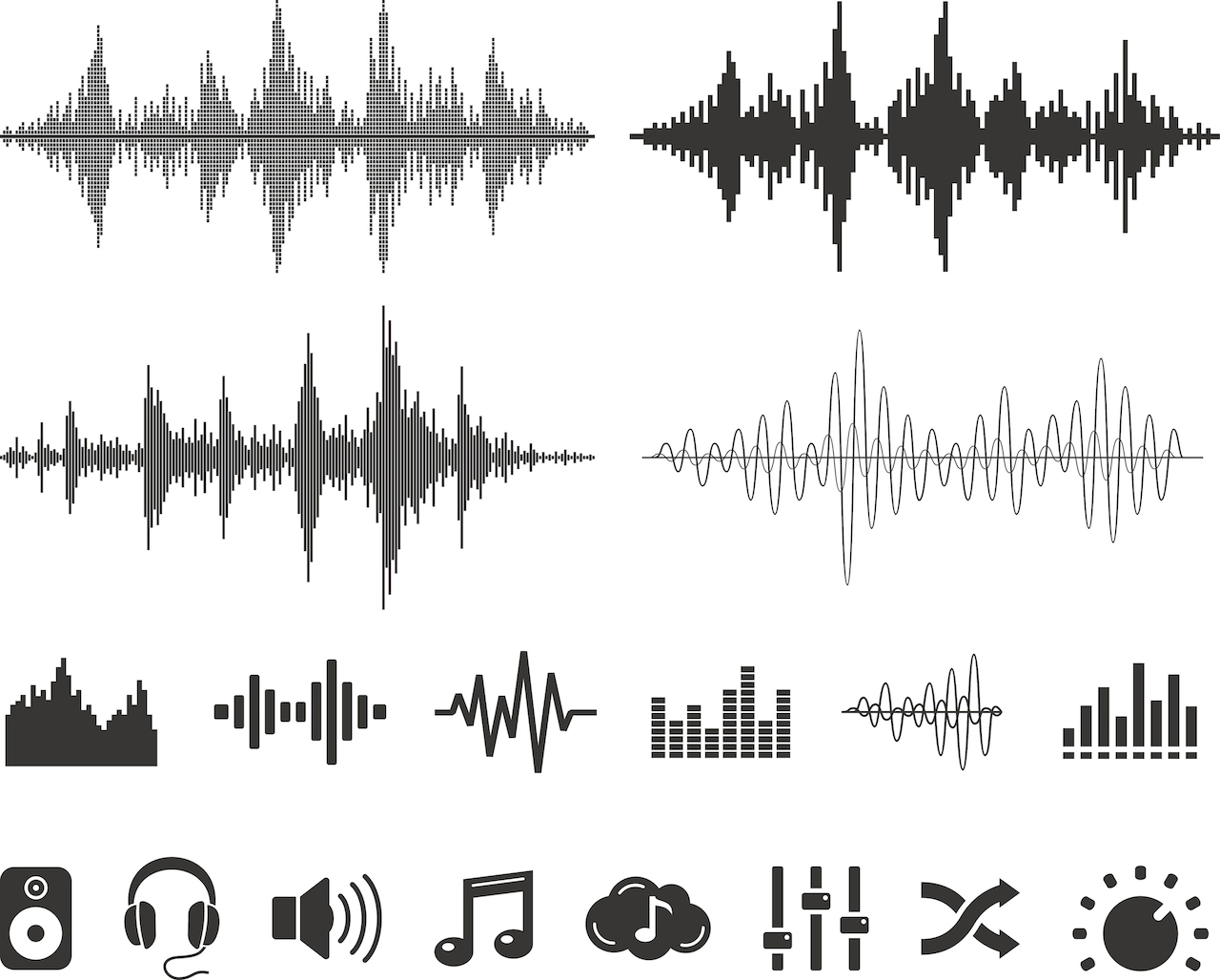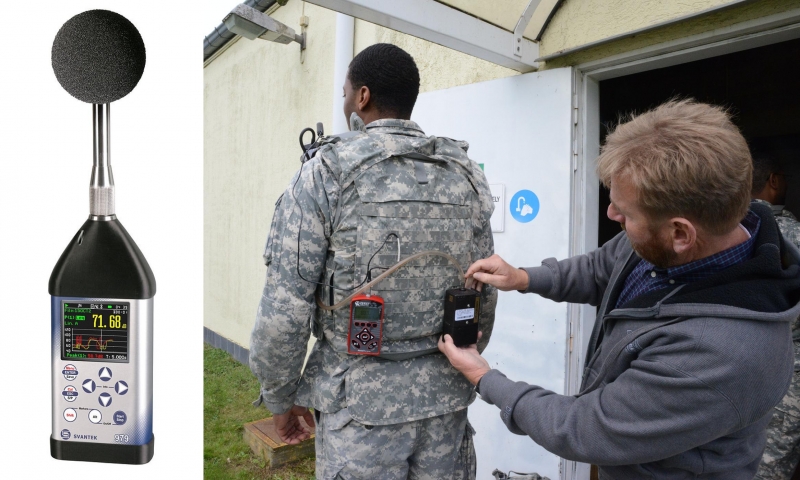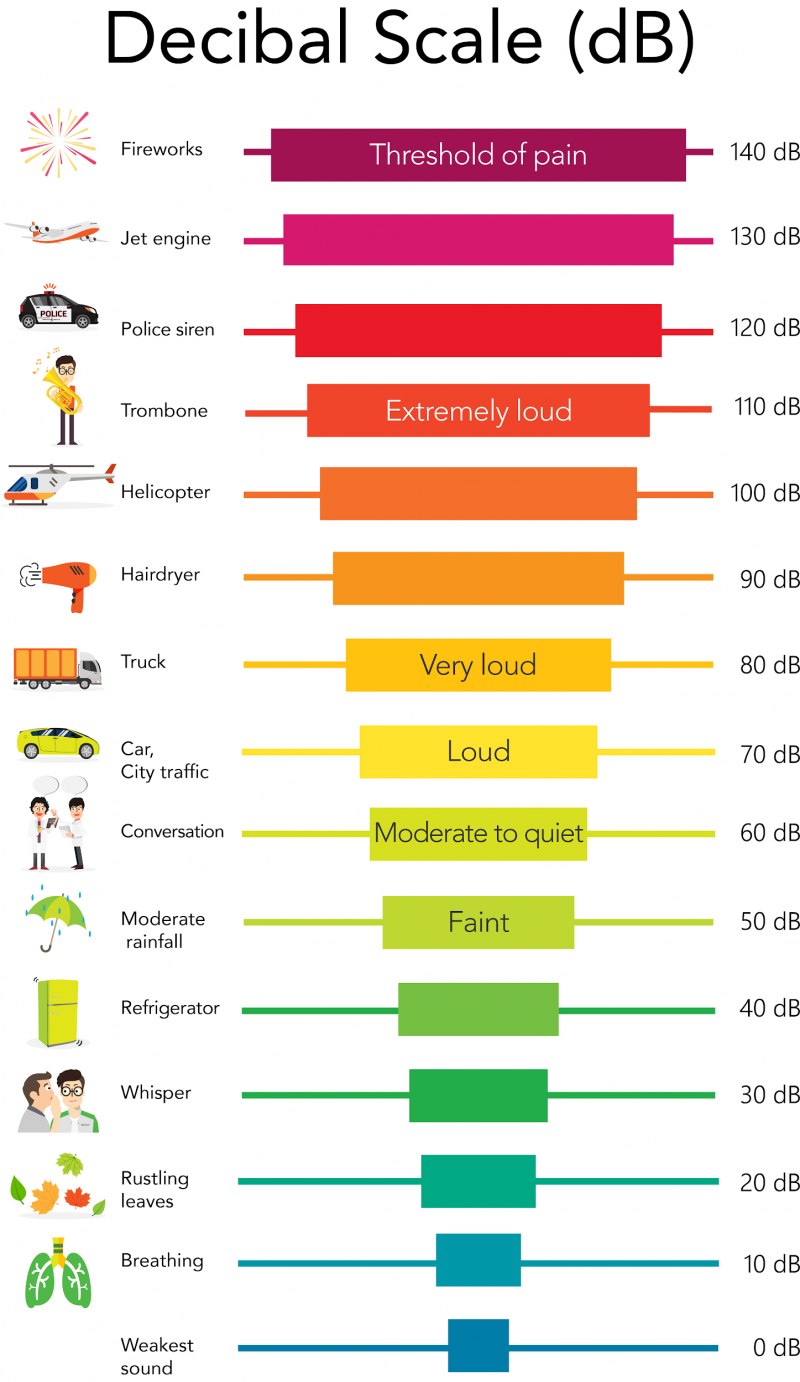Sound vs. Noise

Sound waves and sound-producing devices. Image © jop_pop, istockphoto.com

Sound waves and sound-producing devices. Image © jop_pop, istockphoto.com
What is the difference between sound and noise? How do they affect your hearing? And is noise always a bad thing?
Imagine that you are studying in your room. Meanwhile, your neighbor’s dog keeps barking. This makes it difficult to concentrate on your notes. After a while, it starts getting on your nerves. You may think of the barking sound as noise. It’s really annoying, and not something you want to hear while you try to study for your big test!
Are sound and noise the same thing?
At a scientific level, sound and noise are technically the same - they are vibrations in the air (or in water) that we pick up with our ears. The bigger the waves are (their amplitude), the stronger the vibrations are, and the louder the sound is. However, sound is something that we hear in general. Noise is something that we can hear, but don’t necessarily want to hear.
How do we measure sound?
Sound is measured in decibels (dB). Decibels are named after the one-and-only Alexander Graham Bell, scientist and inventor of the telephone.
Did you know?
Alexander Graham Bell was keenly interested in studying sound because both his mother and wife were deaf.
One way sound is measured is with a sound level meter. This device has a microphone connected to an electronic circuit and display. It picks up the amount that air particles are being “pushed around,” which we perceive as sound. These pressures are then translated to electrical signals and displayed as the sound level, measured in dB. This method is usually best for taking a measurement at one point in time. In other words, it’s best for measuring an environment that has a constant level of sound and can be used to see what level of sound someone is exposed to in that area over a day.
Another method is by using a noise dosimeter. This also has a microphone and recorder attached to it, but is used to record sound levels throughout the day and then averages the total noise someone is exposed to. This is usually attached near someone’s ear so it can accurately record the level perceived by the person throughout the day. This is best for measuring environments where sound levels constantly change and is also measured in dB.

What sound levels are safe?
In general, sound levels that are below 85 dB are considered to be safe. However, sound levels that are 85 dB or more are considered dangerous. In fact, the louder the sound, the more quickly it can cause permanent damage to your ears. For example, listening to a song at 85 dB for 8 hours will cause permanent damage. But listening to a song at 100 dB can cause permanent damage within 15 minutes!

In case you are curious, here is a list of sound levels and how quickly these can cause harm. Why does danger rise more quickly than the number of decibels? Because when a sound level rises by 10 dB sound pressure goes up ten-fold. However, because our brains adjust what we hear, it only sounds twice as loud to us.
Sounds don’t have to be damaging to be uncomfortably loud, though. Most people find sounds in the range of 60-65 dB uncomfortable. The World Health Organization (WHO) suggests that the optimal sound level in a classroom should be at or below 35 dB.
What are the negative effects of noise?
Noise doesn’t necessarily have to be loud to have an effect on someone’s health. For example, a squeaky door which keeps opening and closing is not loud, but can be extremely annoying! Some negative effects of such noise may include:
-
You feel more stressed than usual
-
You heart beats faster than usual
-
You sweat more than usual
-
You are unable to sleep well
-
You get angry or annoyed by the smallest things
-
You feel anxious and uneasy
In some extreme cases, people who are constantly exposed to stressful noises can end up with cardiovascular disorders, such as heart attacks or heart disease.
Did you know?
The sound of nails on a chalkboard is on a list of the most annoying sounds in the world!
Often, people feel their quality of life can be affected by noise as well. For example, some people have a harder time enjoying their backyard because of nearby traffic or overhead aircraft sounds.
What are the positive effects of noise?
Okay, so we have been focused on all the negatives when it comes to noise. But, there are some positives as well! Music can help you work more efficiently, especially when you’re doing routine or less difficult tasks.However, studies have shown that music can make it harder for you to work on more complex tasks, such as learning something new.

In other words, music tends to be more helpful when doing daily chores, but may not be the best idea when you are trying to solve complex physics problems for homework. The reason for this is when you are overwhelmed or stressed, extra noise can worsen your stress levels. But, it can still be helpful in giving you extra focus when you are just reviewing old information.
Let’s do a little recap...
-
Sound is measured mainly in decibels. You can measure sound at a specific point in time with a sound level meter or get an average of sound levels over a period of time with a noise dosimeter.
-
Sounds that are 85 dB or greater can be dangerous and cause long-term damage to your hearing. Ideally, it is best to listen to sounds less than 85 dB.
-
Sound can have negative and positive effects depending on the situation and type. Unwanted sounds (AKA “noise”) which annoy you can lead to a stress response. This can make you anxious and irritable. When you’re doing complex tasks (like learning new information), noise can make it difficult for you to focus. However, music can be helpful and make you more creative when doing less difficult tasks. It may also help you focus on certain routine tasks as well.
Sound is not as simple as you may have thought! As you can see, sound and noise can affect you in different ways. Who knew listening could be so complex?
Starting Points
- When you are doing homework, do you prefer to have it really quiet, or do you like background noise?
- Have you ever worn ear protection? What noise(s) were you protecting yourself from?
- What is the most annoying sound in your opinion? Do your friends think the same? Find out!
- In what occupations and situations are sound levels important to measure?
- In what situations do you think people are most at risk for sound-related hearing damage in everyday life?
- Do you believe our world is getting noisier? Explain.
- What is the difference between “sound” and “noise”? Is this difference based on science?
- What is the range of frequencies that human beings can hear?
- What is a decibel? What type of scale is used when measuring decibels?
- Is it possible for a sound to be 0 dB? Why or why not?
- Can you think of some technologies that have been developed to help reduce noise levels or the impact of noise in our world?
- Just as our technological ability to see things that are very far away or very small has improved over time, so has our ability to hear minute sounds over very long distances. What are some the smallest sounds and most remote sounds that we are able to hear as a result of advances in technology? (Note: This question will require some research.)
- What are sound effects? What role do they play in a film you particularly like?
- Create a short video and enhance it with addition of sound effects. Think about how you will produce the sounds you need. Evaluate the success of your sound effects in terms of how it enhanced the video viewing experience.
- This article supports teaching and learning of concepts related to sound and hearing, and hearing health. It introduces the concepts of sound, noise, decibel scale and amplitude.
- Before reading the article could complete a Vocabulary Preview learning strategy to help students access prior knowledge and introduce new terminology. Ready-to-use Vocabulary Preview reproducibles are available in [Google doc] and [PDF] formats. Students could continue to fill in the Vocabulary Preview during and after reading the article.
- For a focus on hearing health, students could conduct discussions based on the questions presented in the Relating Science and Technology to Society and the Environment section.
- Students could compare the features and characteristics of sound versus noise using a Venn Diagram.
- If the school has access to a sound level meter, students could learn how to use the device and take it to different locations in the school during different activities to take sound level measurements. They could then assess if the sound levels were in a safe or dangerous range.
Connecting and Relating
- When you are doing homework, do you prefer to have it really quiet, or do you like background noise?
- Have you ever worn ear protection? What noise(s) were you protecting yourself from?
- What is the most annoying sound in your opinion? Do your friends think the same? Find out!
Relating Science and Technology to Society and the Environment
- In what occupations and situations are sound levels important to measure?
- In what situations do you think people are most at risk for sound-related hearing damage in everyday life?
- Do you believe our world is getting noisier? Explain.
Exploring Concepts
- What is the difference between “sound” and “noise”? Is this difference based on science?
- What is the range of frequencies that human beings can hear?
- What is a decibel? What type of scale is used when measuring decibels?
- Is it possible for a sound to be 0 dB? Why or why not?
Nature of Science/Nature of Technology
- Can you think of some technologies that have been developed to help reduce noise levels or the impact of noise in our world?
- Just as our technological ability to see things that are very far away or very small has improved over time, so has our ability to hear minute sounds over very long distances. What are some the smallest sounds and most remote sounds that we are able to hear as a result of advances in technology? (Note: This question will require some research.)
Media Literacy
- What are sound effects? What role do they play in a film you particularly like?
- Create a short video and enhance it with addition of sound effects. Think about how you will produce the sounds you need. Evaluate the success of your sound effects in terms of how it enhanced the video viewing experience.
Teaching Suggestions:
- This article supports teaching and learning of concepts related to sound and hearing, and hearing health. It introduces the concepts of sound, noise, decibel scale and amplitude.
- Before reading the article could complete a Vocabulary Preview learning strategy to help students access prior knowledge and introduce new terminology. Ready-to-use Vocabulary Preview reproducibles are available in [Google doc] and [PDF] formats. Students could continue to fill in the Vocabulary Preview during and after reading the article.
- For a focus on hearing health, students could conduct discussions based on the questions presented in the Relating Science and Technology to Society and the Environment section.
- Students could compare the features and characteristics of sound versus noise using a Venn Diagram.
- If the school has access to a sound level meter, students could learn how to use the device and take it to different locations in the school during different activities to take sound level measurements. They could then assess if the sound levels were in a safe or dangerous range.
Learn more
How Our Ears Work (2013)
Video (5:07 min.) from Kids Health about how the ear works.
Interactive page from Dangerous Decibels on what sound is, how loud something needs to be to cause damage to your ears, and how to protect your hearing.
What Is the Most Annoying Sound? (2012)
Article from the Smithsonian Institute on what sounds the brain universally dislikes, and here is a link to the top 5 worst sounds.
Can “Distracting” Noise Actually Help You Study Better? (2017)
Article by Kaitlin Goodrich for BrainScape on the effects of noise on the brain while studying.
References
Barone, J. (2017). Sounding off on noise. Berkeley Wellness.
Canadian Centre for Occupational Health and Safety. (2019). Measurement of workplace noise.
Canadian Centre for Occupational Health and Safety. (2019). Noise – Basic information.
Dangerous Decibels. (2019). DdB: Measuring sound.
Hear-it. (2019). Classrooms are far too noisy.
Lesiuk, T. (2005). The effect of music listening on work performance. Psychology of Music, 33(2), 173–191. https://doi.org/10.1177/0305735605050650
Perham, N., & Vizard, J. (2010). Can preference for background music mediate the irrelevant sound effect?. Applied Cognitive Psychology, 25(4), 625-631. DOI: 10.1002/acp.1731
Sengpiel, E. (2019). What is amplitude? Sengpielaudio.com.